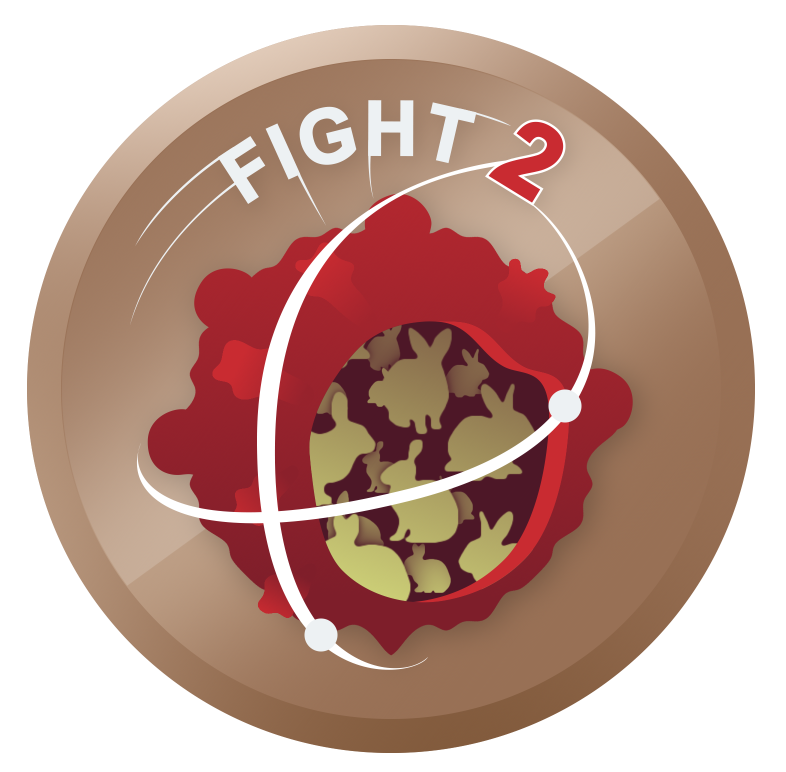About the Project
The strategic framework FIGHT-TWO (PTDC / CVT-CVT / 29062/2017-PT2020) is the development and production of an oral and safe vaccine against RHDV2 for the wild rabbit.
This edible vaccine will be distributed in the field as bait or dry food and has the potential to protect a large proportion of the wild rabbits populations, crucial for reducing virus transmission and controlling infection, overcoming the need for capture and handling of the animals.
This edible vaccine will be distributed in the field as bait or dry food and has the potential to protect a large proportion of the wild rabbits populations, crucial for reducing virus transmission and controlling infection, overcoming the need for capture and handling of the animals.
This new vaccine will be developed using biotechnology and is based on viral-like particles (VLPs) of the largest structural (capsid) protein of RHDV2, the VP60 protein. The VP60-VLPs are protein structures (“hollow cages”) that mimic the general structure of native virions but are devoided of genetic material (RNA) inside, although they allow to induce a protective immune response when administered parenterally or orally. This recombinant vaccine will be produced in an insect-baculovirus cell expression vector system (IC-BEVS) and updated according to the evolution of the virus (open system).
The project's partnership includes the National Institute for Agricultural and Veterinary Research (INIAV), a reference laboratory for animal diseases, two Portuguese Veterinary Universities, namely the University of Évora (UÉ) and the Faculty of Veterinary Medicine of Lisbon (FMV) and the Institute of Experimental and Technological Biology (iBET), a private institute with extensive experience in the field of vaccine production.
The FIGHT-TWO project will allow to proceed with one of 12 measures specified in an Action Plan for the Control of Rabbit Haemorrhagic Viral Disease in Wild Rabbits (Order 4757/17 of May 31, Ministry of Agriculture), supporting more generalist management policies towards the recovery of wild rabbit population densities, the control of RHD, the recovery of ecosystems where the rabbit is keystone and the reactivation of hunting activity in Portugal.
The FIGHT-TWO project, reference PTDC / CVT-CVT / 29062/2017-PT2020, is funded by the Foundation for Science and Technology (FCT), the national public agency for science research, technology and innovation, in all areas of knowledge, under the tutelage of the Ministry of Science, Technology and Higher Education.
The importance of the wild rabbit
The wild rabbit (Oryctolagus cuniculus) is a native species from the Iberian Peninsula belonging to genus Oryctolagus, family Leporidae and order Lagomorpha. Two subspecies are recognized, O. cuniculus algirus restricted to southwest of the Iberian Peninsula, North of Africa and Atlantic islands, and O. cuniculus cuniculus, which inhabits the north-eastern part of the Iberian Peninsula and is widespread in the other locations where the species occurs. The subspecies O. c. algirus acquires special importance in the problematic of rabbit preservation, given its restricted geographical distribution and its frail conservation status, recently revised to “Endangered” by the International Union for Conservation of Nature (IUCN).
Rabbit Haemorrhagic disease
Rabbit haemorrhagic disease (RHD) is a highly contagious and often lethal systemic viral infection in the European rabbit (O. cuniculus). RHD integrated the list of notifiable diseases. Presently, the condition is caused by the rabbit haemorrhagic disease virus type 2 (RHDV2), a small, fast evolving RNA virus belonging to the Caliciviridae family, which emerged in France in 2010. RHDV2 has replaced the genogroups (G1-G6) of classical RHDV that circulated previously in all the geographic locations were it has been reported. This virus has had great impact on the conservation of the diminished Iberian wild rabbit populations, directly affecting several threatened species that depend on the rabbit for survival, namely the “Endangered” Iberian Lynx (Lynx pardinus) and the “Vulnerable” Iberian Imperial Eagle (Aquila adalberti).
In Portugal, RHDV2 was detected for the first time in 2012 and is currently widely distributed in the entire national territory, including the Azores and Madeira archipelagos.
Currently available vaccines
The commercial vaccines against RHDV2 available to date are inactivated, obtained from infected animal liver extracts and the route of administration is usually subcutaneous, requiring handling. Further than the risks associated with incomplete virus inactivation and the inadvertent release of infectious virus, these vaccines are not suitable for wild rabbits, requiring capture for inoculation. The immunity is short and, hence, the protection transient. The previous commercial RHDV vaccines, most also inactivated, were shown to be ineffective in conferring cross protection against RHDV2.
The FIGHT-TWO project
The FIGHT-TWO (PTDC/CVT-CVT/29062/2017-PT2020) strategic framework is the development and production of a new edible vaccine against RHDV2. This pathogen-free vaccine based in VP60 (major capsid) Virus-Like Particles (VLPs), will be distributed in the field as bait or in dry feed. This non-invasive immunization has the potential to protect a broad proportion of the populations, crucial to stop virus transmission and control the infection, while overcoming the need of capture and manipulation.
This recombinant vaccine will be produced using the insect cells-baculovirus expression vector system (IC-BEVS), and updated accordingly to RHDV2 evolution in an open system.
Connection with projects + Coelho
FIGHT-TWO will allow to proceed with one of the 12 measures specified in the Action Plan for the Control of Rabbit Haemorrhagic Viral disease in Rabbits (Dispatch 4757/17 of 31 May). Obtaining this vaccine will be crucial to support more generalist wild rabbit management policies towards the recovery of population densities and disease control, the recovery of ecosystems where the rabbit is keystone and the reactivation of hunting activities in Portugal.



